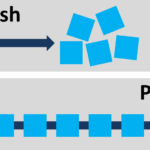Mostly we find a supply chain as merger of both push and pull systems, where the medium between the stages of the push-based and the pull-based systems is referred as the push–pull boundary.
The terms push and pull were framed in logistics and supply chain management, but these terms are broadly used in the field of marketing as well as in the hotel distribution business.
To present an example, Wal-Mart implements the push vs. pull strategy. A push and pull system in business represents the shipment of a product or information between two subjects. Generally, the consumers use pull system in the markets for the goods or information they demand for their requirements whereas the merchants or suppliers use the push system towards the consumers.
In supply chains, all the levels or stages function actively for the push and the pull system. The production in push system depends on the demand predicted and production in pull system depends on absolute or consumed demand.
The medium between these two levels is referred as the push–pull boundary or decoupling point. Generally, this strategy is recommended for products where uncertainty in demand is high. Further, economies of scale play a crucial role in minimizing production and/or delivery costs.
For example, the furniture industries use the push and pull strategy. Here the production unit uses the pull-based strategy because it is impossible to make production decisions on the basis on long term prediction. Meanwhile, the distribution unit needs to enjoy the benefits of economy of scale so that the shipment cost can be reduced; thus it uses a push-based strategy.


